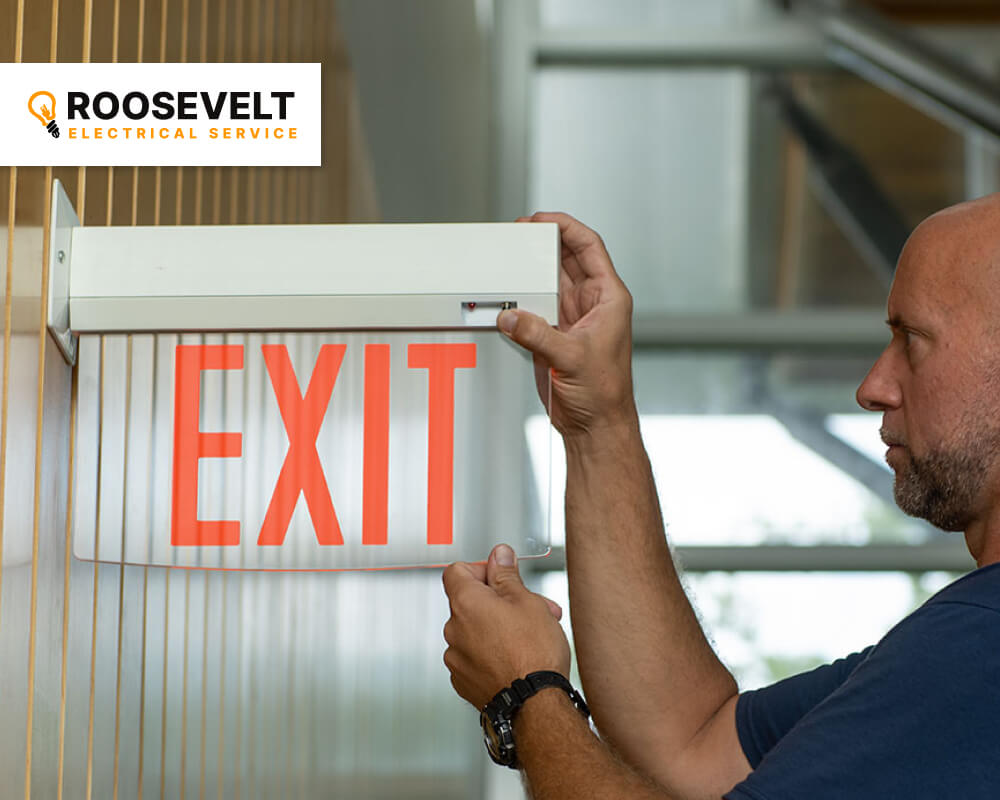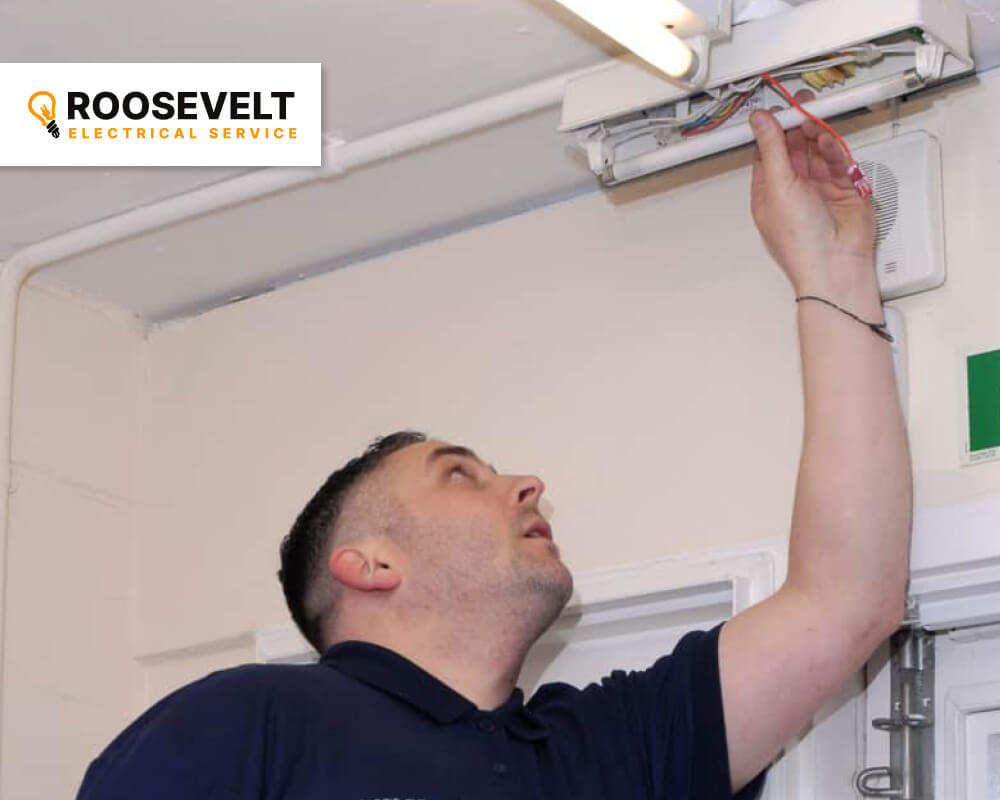
Emergency lights are essential for many businesses and public spaces as a safety measure for emergencies, such as fires and power outages. Emergency lights use a backup power source to illuminate key areas in these spaces, such as emergency exits, when other lights are functioning. These lights have an independent power source to keep them working if there is no power.
Beyond its obvious safety benefits, emergency lights are also required by law. Individuals or companies that do not comply with this safety code face a hefty fine and penalty. If you need a professional to install emergency lights in your business, Roosevelt Electrical Services is here to help.
So how do you install emergency lights? Because of their importance, take special care to ensure they are installed properly and serviced regularly. Before doing any lighting installation, consult an electrician to follow all safety procedures. You can also choose to have a licensed electrician install the fixture.
There are two primary ways to mount your emergency light. They are usually attached to the wall or ceiling before connecting the wiring. They will either have holes to be drilled into the wall or use a mounting bracket.
Wall Mounting Installation:
- Take off the mounting pattern cutouts to allow the wires to pass through.
- Install the bushing into the wire holes. The bushings are insulators that allow electricity to pass without contact with the fixture.
- Attach the wires to the sign.
Ceiling Mounting Installation:
- Remove the wire cutouts from the top or sides of the unit.
- Attach the canopy to the sign using the provided screws and hardware.
- Use the longest screws in the outer holes to attach the unit.
- Pull the wiring through the center hole and fasten the plate to the electrical box.
- Maneuver the wires through the pass hole and into the power pack.
- Place the fixture canopy onto the electrical box.
- Secure the canopy using nuts.
- Once mounted, cover the wiring with thermoplastic housing.
Making The Connection:
You must make two or three connections to your electrical system to install your emergency lights properly. Review the instructions to establish the necessary voltage for the fixture. The wires should feature the following:
- A white, single common wire
- A 120-volt black wire
- A 277-volt red wire
- An optional green ground wire
Connect the appropriate voltage wires from your house to the unit. Use wire strippers to remove the wire cover to make the connections more secure. Do not use the 120-volt and 277-volt wires together, as it will cause the fixture to malfunction.
Additional TIPS:
- Consider getting LED emergency lights, which are brighter and have a longer lifespan than older incandescent and halogen lights.
- Plan emergency escape paths and strategically place your emergency lights to provide the quickest evacuation routes.
- Schedule routine maintenance and inspections to ensure your lighting is operational.
5 Best Places to Install an Emergency Lighting Fixture

When your business is affected by a power outage, it is essential to have a reliable source of light to illuminate emergency exits or dark hallways. Emergency lighting is among the most important safety fixtures in commercial buildings. While it is easy to see its importance, it is just as important to understand its installation, testing, and maintenance requirements set by national and local authorities.
Why is emergency lighting important? Emergency lighting systems help guide building occupants to emergency exits and safe areas in the building during a power outage or emergency. Emergency lights, panic doors, and exit signs are safety devices that are just as important as fire alarms. Emergency lighting illuminates pathways, staircases, and dark hallways to ensure the safe passage of occupants.
What are the regulatory requirements for emergency lighting? According to NFPA, all commercial buildings should have an emergency and exit lighting. The NFPA Safety Code 101 is updated every three years to ensure new facilities offer the best safety from fire and other hazards for occupants.
So, where should you install emergency lighting? Buildings that have occupants at any time of the day must have emergency path lighting. However, three structures are exempt from this requirement:
- Buildings that are only occupied and used during the daytime have enough natural light to illuminate all areas. Emergency pathways should be illuminated by natural light at all times.
- Buildings that are not routinely occupied.
- Towers designed for less than three people at any time with an escape ladder.
If your structure does not fall into these exemptions, you need to provide a safe way for people to leave using emergency lighting. Common places where you need to install emergency lighting include:
- Windowless rooms larger than a broom closet
Windowless rooms are pitch dark when there are no lights. Hence, you should install emergency lights to ensure occupants can find their way around and out of the room during an outage or emergency.
- Emergency stairs
Stairs used for emergencies must be illuminated, especially when people need to use them. Dark staircases are accident hazards.
- Hallways or corridors leading to an exit
Long hallways and corridors are especially important to keep illuminated during emergencies to give occupants a visual of where they are and where they should go.
- Escalators leading to an exit
Any exit point should be illuminated at all times to guide occupants when needed.
- Doors with sensor-release electrical locking systems
While these sensor-type doors are high-tech, they do need enough illumination for the sensors to detect occupants and unlock the doors.
Since building occupants rely on emergency lighting to safely guide them out of emergencies, it is essential to keep your lighting system functional at all times by testing it regularly. Without following the necessary testing guidelines, you are risking the safety of the building’s occupants.
Emergency lights are important in buildings that have areas with no natural lighting and those that are used during night time. Emergency lights help occupants pass safely through the building even when the power is out. Emergency lights are designed to turn on when power is out, illuminating important exit points and passageways that lead to exits.
With your knowledge of the importance of emergency lights and where they should be installed, feel free to contact us to help safely install yours to ensure the installation will follow all safety requirements. Call us anytime or use our contact form for a callback at your preferred time.

